The Public Works Authority (Ashghal) has announced the commencement of the actual excavation of a 10km-long outfall tunnel as part of Mesaimeer Pumping Station and Outfall project that started in May last year.
This marks an important step towards providing a sustainable solution for the discharge of surface and storm water in the country, Ashghal has said in a statement.
During a site visit to the project on Sunday, Ashghal inaugurated the operational commencement of the Tunnel Boring Machine (TBM) that will be used for the tunnel excavation. In attendance was Dr Saad bin Ahmad al-Muhannadi, president of the Public Works Authority; Khalid al-Khayarin, manager of the Drainage Networks Projects Department; other Ashghal officials and representatives of the supervising consultants and contractors.
On this occasion, Dr al-Muhannadi said: “The commencement of the excavation of the outfall tunnel is an important stage within the Mesaimeer Tunnel project, which is one of the most important projects implemented by Ashghal, and that will accommodate surface and storm water volumes received from the drainage networks located in different areas in Doha. The water is treated according to the highest internationally approved specifications, and then pumped 10km away from the seashore via the Mesaimeer pumping station and outfall tunnel, which is one of the longest outfall tunnels in the world.”
Al-Khayarin said the excavation of the outfall tunnel would be at a depth of 15m below the seabed and about 3.7m in diameter, and is considered a “major construction challenge due to the variable geology that increases the exposure to unexpected conditions”.
Such excavation works require a drilling machine and crew with special capabilities, Ashghal has stressed.
The excavation will be done using a highly specialized TBM that uses a technique called Earth Pressure Balance and is designed to operate in a range of ground conditions in Qatar, and along the variable geology along the tunnel, the statement notes.
The TBM machine incorporates advanced technologies that ensure the efficiency of the drilling process, providing the maximum safety standards for tunnel workers and operators, as well as monitoring the work execution through all its stages.
The safety features include a “closed mode” feature, used in the case of ground deterioration to prevent water from entering the tunnel and thus protect the workers, in addition to rescue chambers that protect personnel during emergencies, fire detection and suppression, as well as emergency electricity generation systems, according to Ashghal.
Mesaimeer Pumping Station and Outfall project
The second part of the project includes a pumping station with 10 pumps and auxiliary facilities. The pumping station will be located at the end of Mesaimeer Tunnel south of Hamad International Airport. The pumping station will operate at a capacity of 19.7 cubic meters per second to pump water from Mesaimeer Tunnel, which was completed in 2016, to the new outfall tunnel.
The project is designed to ensure the preservation of the marine environment, as the water that will be pumped complies with the environmental assessment standards, and it is discharged 10km offshore to reduce the effect on the marine environment.
The excavation works of the outfall tunnel and the construction of Mesaimeer Pumping Station is scheduled to be completed by Q4, 2021, at a total cost of about QR920mn.
The contractor is obligated to maintain and operate the project for a period of at least three years. The project is being implemented by a joint venture of Hamad Bin Khalid Contracting Company and PORR Qatar Construction Company. The project management services have been assigned to Mott Macdonald Ltd, which will oversee the design, implementation and operation of the project.
Mesaimeer Surface and Storm Water Drainage Tunnel Project
Mesaimeer Pumping Station and Outfall is the second phase of the Mesaimeer Surface and Storm Water Drainage Tunnel Project implemented to achieve the objective of Mesaimeer Tunnel, which aims to discharge the surface and storm-water, thereby decreasing the surface water level and reducing pumping costs in construction projects around the country. It will also preserve the foundations of buildings, and reduce land subsidence due to rain.
Mesaimeer Tunnel, completed in late-2016, is one of the projects implemented by Ashghal in the field of drainage networks development.
The tunnel extends below F-Ring Road for 10km with a depth of about 30m below the ground surface. This main tunnel is linked to the existing and planned drainage networks in the areas that traverse through, and will collect and discharge surface water from approximately 170sq km of catchment area.
Gulf Times
04/02/2019

























































